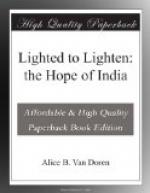Chiefly, however, it is among the Christian community that woman’s freedom has become a fact. Women such as Mrs. Naidu exist, but they are few. Now and then one reads of a case of widow-remarriage successfully achieved. Too often, however, the Hindu reformer, however well-meaning and sincere, talks out his reformation in words rather than deeds. He lacks the support of Christian public opinion; he lacks also the vitalizing power of a personal Christian experience. It is easy to speak in public on the evils of early marriage; he speaks and the audience applauds. He knows too well that in the applauding audience there is not a man whose son will marry his daughter if she passes the age of twelve. So the ardent reformer talks on, with the abandon of the darky preacher who exhorted his audience “Do as I say and not as I do”; and hopes that in some future incarnation life will be kinder, and he may be able to carry out the excellent practices he really desires.
A Hindu girl of high family was allowed to go to college. There being then no women’s college in her part of India, she entered a Government University in a large city, where there were a few other women students. Western standards of freedom prevailed and were accepted by men and women. Rukkubai shared in social as well as academic life. With a strong arm and a steady eye, she distinguished herself at tennis and badminton, and came even to play in mixed doubles, a mark of the most “advanced” social views to be found in India.
After college came marriage to a man connected with the family of a well known rajah. The husband was not only the holder of a University degree similar to her own, but a zealous social reformer, eloquent in his advocacy of women’s freedom. Life promised well for Rukkubai. A year or two later a friend visited her behind the purdah, with the doors of the world shut in her face. The zeal of the reforming husband could not stand against the petty persecutions of the older women of the family. “I wish,” said Rukkubai, “that I had never known freedom. Now I have known—and lost.”
[Illustration: Will life be kind to her?]
Yet not all reformers are such. There are an increasing number whose deeds keep pace with their words. Such may be found among the members of The Servants of India Society, who spend part of the year in social studies; the remainder in carrying to ignorant people the message they have learned.
Such is the heritage of the Hindu woman of ancient freedom; centuries when traditions of repression have gripped with ever-tightening hold; to-day a new ferment in the blood, a new striving toward purposes half realized.
Of to-morrow, who can say? The future is hidden, but the chapters that follow may perhaps serve to bring us into touch with a few of the many forces that are helping to shape the day that shall be.
[Footnote 1: History of India, E.W. Thompson. Christian Literature Society, London and Madras, pp. 11-12.]




